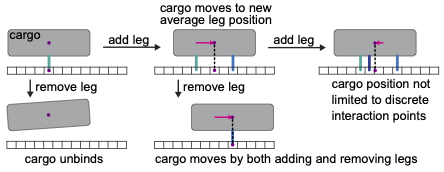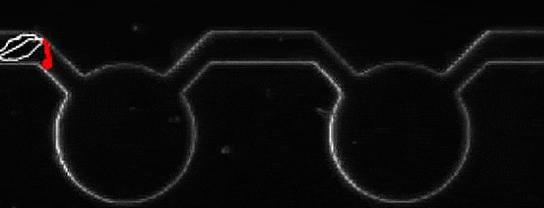How do you move on a substrate if you have many “legs”? Together with Lewis Mosby and Anne Straube we have explored this problem in a paper just accepted on the Journal of Royal Society Interface (link; a version of this work is also available on the arXiv). Turns out that the spatial variation of binding rates can make you surf fast enough to follow the polymerisation of the substrate… all captured analytically!
Long time no see
It’s a long time since our last post… mea culpa for neglecting the thread. …but we haven’t been idle! In this period we have been awarded a new grant to look at the stochastic dynamics of the flagellar tip (currently searching for a 2Y postdoc, btw!), together with Idan Tuval we have hosted Henry Fu (U. Utah) for a 6-months mini sabbatical, we are finalising a few papers (cargo transport, active-passive systems, Micromonas motility, etc.) and have hosted our first undergrads from the Physics Department of UIB (Ana Maya Sevilla, Jorge Pottiez and Cristina Martí). Meeting-wise, amongst other things the 2023 ASLO meeting took place in Palma in June. Marco gave an invited talk in the session “From Single Cells to Ecosystems Scales” (org. Soeren Ahmerkamp, Lars Berendt, Klaus Koren) and organised, together with Soeren, a hybrid mini workshop on the same theme at IMEDEA. We’re happy to have had people attending (and speaking) from California all the way to Australia. On the outreach side, within the EU Project Ocean Night, we have been directly involved with a lovely night at the Cafe Tres Bandas in Palma (co-organised with Pint of Science), and have organised a visit of high-school science teachers to one of the poster sessions of ASLO 2023.
After a quick break in August, we look forward to new and exciting news for the next academic year! Together with Sara, we’re heading to Philippe Bastin’s lab at Inst. Pasteur to look at Micromonas flagella. This might lead to a new collaboration with Philippe and Raphaël Jeanneret. In Oct-Nov we will be hosting Ashis Mukhopadhyay (Wayne St. Univ., Detroit, USA), partially supported by a Visiting Professor Scholarship from the UIB. Finally, we are exploring a potential collaboration on biophysical aspects of viral infections of microorganisms… more info on this if/when it will take shape!
Bacterial swarms thicken up

New paper out on B. subtilis swarming dynamics! The paper, published in Frontiers of Soft Matter, is a collaboration with Iago and Munehiro and builds on our previous paper on eLife. Here we dwell into the characterisation of the transition from a monolayer to a multilayer swarm. Turns out that this looks like a first order phase transition and can take either a “nucleation and growth” route or a more sudden “spinodal” decomposition route…
The curious case of confined active-passive systems

We’re excited to share our latest publication in Nature Communications, where we investigate the dynamics of mixed active-passive systems. In these systems, the passive particles are buffeted around by the active components like swimming microorganisms or synthetic active particles. These suspensions are fascinating both at a fundamental level (how can we describe/prescribe the average behaviour of the passive particles?) and -possibly- for future technological applications (directed transport at the microscopic scale). Here we show that confining an active-passive system leads to a non-uniform distribution of the passive species in a predictable way. We then use confinement to induce the mixed system to spontaneously un-mix and separate out the passive components! This is Steve’s first paper, in collaboration with Raphaël Jeanneret (LPENS Paris, France) and Idan Tuval (IMEDEA UIB-CSIC, Spain).
Dr Williams
Thrilling news! On Friday Steve has successfully defended his PhD thesis! Dr. Williams, as he’s now known, endured 3h of grilling by Giorgio Volpe (UCL) and Gareth Alexander (U Warwick)… and managed to emerge reasonably unscathed 😉 Steve has gracefully agreed to keep working with us as a postdoc for the next few months. Thanks Steve!
WMS Thesis prize for Iago
We’re very happy to announce that Iago has been awarded the Faculty Thesis Prize from Warwick Medical School, for his thesis “Biophysical mechanisms of antimicrobial resistance in swarming B. subtilis“. The thesis was co-supervised with our good friend Munehiro Asally. Well done Iago! You can read more about Iago’s work in his eLife publication and (hopefully soon) in a second follow-up article.
Iago is currently a postdoc in the Oxford Colloids Group (U. Oxford, UK).
The Narrow-Escape of a Microorganism
Escaping through narrow apertures involves rare events and therefore is usually quite hard. It is also a classical problem for both Brownian and ballistic particles. Interestingly, microorganisms can find themselves having to find and go through a narrow aperture. Their case is peculiar as it bridges the Brownian and ballistic cases. Our new paper, just out in Physical Review Research, looks at this problem with a mix of experiments and simulations. As is often the case, we find an unexpected twist in the story…. A great collaboration with Antoine Allard, Mathieu Souzy, Jean François Louf, Matteo Contino and Idan Tuval.
Steering self-organisation through confinement
We’ve recently participated to an opinion piece on the importance of confinement in self-organisation. The preprint is currently accessible in the [Arxiv]. This work was doggedly led by Nuno Araujo, Liesbeth Janssen, Giorgio Volpe and Alvaro Marin, and it stems from a workshop that they organised at the Lorentz Centre, University of Leiden.
Visit by Shilpa Khatri
We are very excited to welcome Shilpa Khatri, Assistant Professor at UC Merced (USA), who’s joined us at IMEDEA about 10 days ago for a 2-months visit. This is funded from a Visiting Fellowship from the University of the Balearic Islands. Between short trips to the continent and co-organising with us and others the 2022 MOB meeting, Shilpa will work with Steve Williams on a numerical project about phototaxis.
Eleonora Secchi’s visit
Over the last three weeks we were lucky enough to host Eleonora Secchi (ETH Zürich). Her visit was supported by a Visiting Fellowship from UIB (calls every 6 months: drop an email if interested!). We had lots of fun working on biofilm streamers by marine bacteria and in general exchanging ideas and learning from each other. Have a good fly back Eleonora and talk soon!

